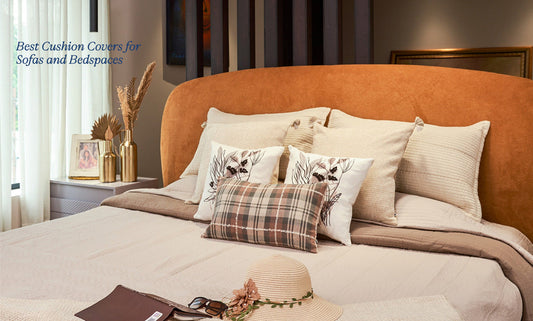When it comes to bedroom décor, cushions for the bed play a significant role in enhancing comfort and aesthetics. While too few cushions can make a bed look sparse, too many can create clutter. Finding the perfect balance is key. In this blog, we’ll explore how many cushions you should have on your bed from a designer's perspective, taking into account functionality, style, and comfort.
The Purpose of Bed Cushions
Bed cushions are more than just decorative elements; they serve multiple purposes:
- Aesthetic Appeal: Bed cushions add depth, texture, and personality to your bedroom.
- Comfort: They provide extra support when sitting up in bed.
- Luxury Feel: A well-styled bed exudes a plush, inviting ambiance.
- Protection: They can act as a barrier for your pillows, keeping them clean.
How Many Cushions Should You Use?
The ideal number of cushions depends on the bed size, personal preference, and design aesthetics. Let’s break it down:
For a Twin Bed
2 to 3 Cushions
- 1 Standard Pillow
- 1 Decorative Cushion
- 1 Lumbar Cushion (Optional): A twin bed should maintain simplicity, focusing on comfort without overwhelming the small space.
For a Double or Full-Size Bed
4 to 5 Cushions
- 2 Standard Pillows
- 2 Decorative Cushions
- 1 Bolster or Lumbar Cushion: This arrangement keeps the bed balanced and cozy without overloading it.
For a Queen-Size Bed
5 to 7 Cushions
- 2 to 4 Standard Pillows
- 2 to 3 Decorative Cushion
- 1 Bolster or Lumbar Cushion: A queen bed offers more space to experiment with textures and layering for a designer touch.
For a King-Size Bed
7 to 9 Cushions
- 3 to 4 Standard Pillows
- 3 Decorative Cushions
- 1 to 2 Bolster or Lumbar Cushions: A king bed allows for a grand display of cushions while maintaining an opulent look.
Choosing the Right Bed Cushion Covers
The right cushion covers can elevate the look of your bedroom. Here are some tips for selecting the best ones:
- Fabric: Cotton, linen, and velvet add texture and richness.
- Color Scheme: Match or contrast with your bedding and room theme.
- Patterns & Textures: Use a mix of solid colors, prints, and embroidery for depth.
- Seasonal Change: Opt for warm, cozy covers in winter and light, breathable fabrics in summer.
Arranging Your Cushions Like a Designer
A well-arranged bed looks inviting and stylish. Here are some design tips:
- Layering Technique: Start with standard pillows at the back, followed by decorative cushions, and finish with a lumbar cushion.
- Odd Numbers Rule: Designers often prefer odd numbers for a balanced yet dynamic look.
- Symmetry vs. Asymmetry: Symmetry creates a classic look, while asymmetry adds modern flair.
Maintaining Your Bed Cushions
To keep your bed cushions in top shape:
- Fluff Daily: Helps maintain their shape and comfort.
- Wash Covers Regularly: Keeps them fresh and hygienic.
- Store Seasonally: Rotate designs based on the season.
- Use Quality Inserts: Good-quality inserts ensure longevity and plushness.
Final Thoughts
Choosing the right number of cushions for your bed is about balancing function and style. Whether you prefer a minimalist look or a luxurious, layered approach, the key is to create a setup that suits your personal taste and complements your bedroom decor.
For high-quality cushions for bed, bed cushion covers, and premium home decor solutions, explore Onset Homes. Their exclusive collection blends comfort with elegance, ensuring your bedroom looks its best!




